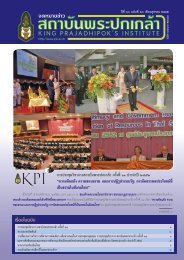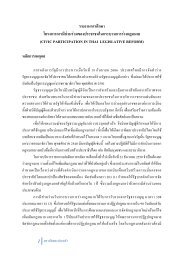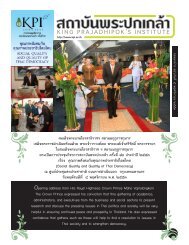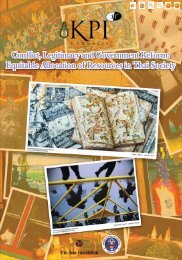SUFFiciENcy EcONOMy ANd GRASSROOtS DEvElOPMENt
SUFFiciENcy EcONOMy ANd GRASSROOtS DEvElOPMENt
SUFFiciENcy EcONOMy ANd GRASSROOtS DEvElOPMENt
Create successful ePaper yourself
Turn your PDF publications into a flip-book with our unique Google optimized e-Paper software.
The Meaning of Sufficiency Economy <br />
International Conference<br />
163<br />
all Americans lived in urban areas. In May 2011 the consumer debt in the US was<br />
$793 billion 6 or $2,583 per capita, man, woman, and child while total household<br />
debt rose to $13.4 trillion in 2011 ($43,647 per capita). 7<br />
How does one find moderation from this extreme? I would like to propose that<br />
the path to this involves scaling back and rebuilding supportive community where,<br />
one person at a time, we rediscover healthy values.<br />
As background, in 2008 there were 29.6 million businesses in the US and<br />
99.9% of those businesses are SMEs. 8 About 55% of all jobs in the private sector<br />
are in SMEs. 9 Over the last decade small business have generated between 60 and<br />
80% of net new jobs annually. 10<br />
In 2009 I studied eight businesses in the Denver, CO area and the business<br />
network that all but one are members of. All of these businesses qualified as SMEs<br />
(less than 500 employees). They ranged in size from no employees to<br />
approximately 350 employees. They were a mixture of manufacturing, service,<br />
retail, and education businesses. They were from brand new businesses to<br />
established businesses, the oldest of which was 18 years old. Save one, all were<br />
members of local networks affiliated with the Business Alliance for Local Living<br />
Economies (BALLE). BALLE is a national network of networks that support<br />
locally owned businesses (mainly SMEs) that are socially and environmentally<br />
responsible. These businesses all started with 1-3 owners. All of the businesses are<br />
driven by commitment to community both within the businesses and in the<br />
geography in which they were located. All of the businesses were guided by<br />
“making a living” rather than “making a killing.” Already we seen an appreciation<br />
of moderation.<br />
The organizational structure of these businesses was very flat as opposed to the<br />
more typical hierarchical structure. Not one of the business owners talked about<br />
employees; they talked about “associates” or “the people that work with me”. All of<br />
the people in the business contributed to the development of the business and the<br />
day-to-day operations. In the cases where the businesses are not employee owned,<br />
the knowledge, skills and opinions of the employees is actively sought and valued.<br />
In these cases, the ultimate decisions on company operations still fall to the owners<br />
who have financial interest in the company. However, the interest of the company is<br />
put ahead of and egoist ownership stance. The oldest of the businesses is an<br />
6<br />
CreditCards.com, http://www.creditcards.com/credit-card-news/credit-card-industry-factspersonal-debt-statistics-1276.php,<br />
11 September, 2011<br />
7<br />
The Wall Street Journal, http://online.wsj.com/article/SB100014240527487<br />
04823004576192602754071800.html, 11 March 2011, 11 September 2011<br />
8<br />
The US Small Business Administration, http://www.sba.gov/advocacy/7495/8425, 11<br />
September, 2011<br />
9<br />
National Federation of Independent Business, http://w.411sbfacts.com/speeches.html, 11<br />
September, 2011<br />
10<br />
Ibid














